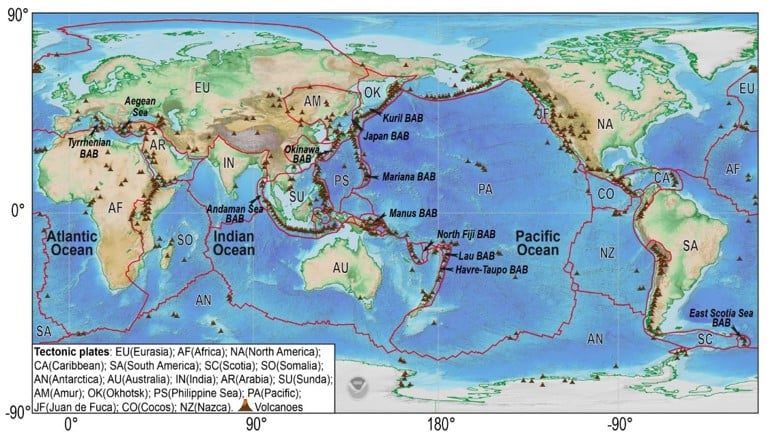Tectonics and Morphology of Back-Arc Basins
A special issue of Geosciences (ISSN 2076-3263). This special issue belongs to the section "Structural Geology and Tectonics".
Deadline for manuscript submissions: closed (15 September 2021) | Viewed by 36260
Special Issue Editors
Interests: geodynamics; structural geology; marine geology and geophysics; geo-hazard; extensional and compressive tectonics
Special Issues, Collections and Topics in MDPI journals
Interests: bathymetry; geomorphology; marine geology; oceanic geodiversity; seafloor spreading
Special Issues, Collections and Topics in MDPI journals
Interests: seafloor mapping; tectonics; submarine volcanism; 3D reconstruction; physical geography; morpho-geodynamics
Special Issues, Collections and Topics in MDPI journals
Special Issue Information
Dear Colleagues,
Back-arc basins open in response to extensional processes of the overriding plate, which in turn is controlled by the subduction of oceanic lithosphere. These systems are usually controlled at wide-scale by plates convergence, as for the cases of the Mediterranean basins, differently from what happen for the two basins in the Atlantic belonging to the Scotia and Caribbean systems. Generally opening starts as symmetric extension, controlled by pure shear system characterized by a series of horsts and grabens bounded by normal faults or listric faults, and evolves as asymmetric controlled by simple shear system generating a series of half grabens and ridges bounded by more complex faults systems. At regional scale, highly evolved basins shown an irregular shape and coexistence of normal, inverse and transcurrent faults. Tectonics strongly influence the morphology of the seafloor, distribution of small sedimentary basins or sub-basins, and it is also one of the main factors able to modify canyons and channel systems connecting the subaerial hydrographic network with abyssal plans. Analysis of the inherited morphology and of the tectonics can help to understand processes at crustal scale that controlled the opening and evolution of back-arc basins, improving knowledge on plates geodynamics.

Dr. Maria Filomena Loreto
Dr. Camilla Palmiotto
Ass. Prof. Paraskevi Nomikou
Dr. Manel Prada
Guest Editors
Manuscript Submission Information
Manuscripts should be submitted online at www.mdpi.com by registering and logging in to this website. Once you are registered, click here to go to the submission form. Manuscripts can be submitted until the deadline. All submissions that pass pre-check are peer-reviewed. Accepted papers will be published continuously in the journal (as soon as accepted) and will be listed together on the special issue website. Research articles, review articles as well as short communications are invited. For planned papers, a title and short abstract (about 100 words) can be sent to the Editorial Office for announcement on this website.
Submitted manuscripts should not have been published previously, nor be under consideration for publication elsewhere (except conference proceedings papers). All manuscripts are thoroughly refereed through a single-blind peer-review process. A guide for authors and other relevant information for submission of manuscripts is available on the Instructions for Authors page. Geosciences is an international peer-reviewed open access monthly journal published by MDPI.
Please visit the Instructions for Authors page before submitting a manuscript. The Article Processing Charge (APC) for publication in this open access journal is 1800 CHF (Swiss Francs). Submitted papers should be well formatted and use good English. Authors may use MDPI's English editing service prior to publication or during author revisions.
Keywords
- Back-arc basin
- Morphology
- Tectonics
- Pure shear
- Simple shear
- Canyon
- Geodynamics
- Inverse faults
- Listric / Normal faults
- Transcurrent faults
Benefits of Publishing in a Special Issue
- Ease of navigation: Grouping papers by topic helps scholars navigate broad scope journals more efficiently.
- Greater discoverability: Special Issues support the reach and impact of scientific research. Articles in Special Issues are more discoverable and cited more frequently.
- Expansion of research network: Special Issues facilitate connections among authors, fostering scientific collaborations.
- External promotion: Articles in Special Issues are often promoted through the journal's social media, increasing their visibility.
- Reprint: MDPI Books provides the opportunity to republish successful Special Issues in book format, both online and in print.
Further information on MDPI's Special Issue policies can be found here.







